Soil Depth Prediction Model Using Terrain Attributes in Gangwon-do, South Korea
Abstract
:1. Introduction
2. Methodology
2.1. Study Area and Terrain Attributes
2.2. Statistics Analysis
2.2.1. Correlation Analysis
2.2.2. Multi-Collinearity Analysis
2.2.3. Multi-Linear Regression Analysis
- (1)
- As the number of variables used in the model decreases, decreases: Especially, a large decrease in Cases No. 5 and 6.
- (2)
- Since Cases No. 1 and 2 have multi-collinearity problems, suitable models are Cases No. 3 and 4.
- (3)
- Case No. 4, compared to Case No. 3, has a relatively large error.
- (4)
- Applied Model in this study is Case No. 4, since it uses fewer variables than in Case No. 3.
3. Predicted Soil Depth Model
4. Conclusions
- -
- The regression model uses open data provided by the Geotechnical Information DB System; a total of 297 sites were obtained. They were classified into 101 sites for igneous rock, 101 for metamorphic rock, and 95 for sedimentary rock.
- -
- As a result of analyzing the correlation between the six TAs obtained from the numerical map and soil depth, the variables with the highest correlation are SLOPE, and curvature and SCA are found to have relatively low correlation. In addition, a model using three variables (SLOPE, STI, TWI) is determined from , and RMSE values for multi-collinearity analysis and the combination of six cases for variables.
- -
- For the models of igneous rock, metamorphic rock, and sedimentary rock, the values are 0.698, 0.676, and 0.683, respectively, and the RMSE values are 0.870, 0.876, and 0.981. Additionally, Verification sites used data from 18 igneous rock sites, 37 metamorphic rock sites and 30 sedimentary rock sites. The values are 0.859, 0.794, 0.807, and the RMSEs are 0.724, 1.104, 0.288 for igneous, metamorphic, and sedimentary rocks, respectively.
Author Contributions
Funding
Institutional Review Board Statement
Informed Consent Statement
Data Availability Statement
Conflicts of Interest
References
- Kuriakose, S.L.; Devkota, S.; Rossiter, D.G.; Jetten, V.G. Prediction of soil depth using environmental variables in an anthropogenic landscape, a case study in the Western Ghats of Kerala, India. CATENA 2009, 79, 27–38. [Google Scholar] [CrossRef]
- Mehnatkesh, A.; Ayoubi, S.; Jalalian, A.; Sahrawat, K. Relationships between soil depth and terrain attributes in a semi arid hilly region in western Iran. J. Mt. Sci. 2013, 10, 163–172. [Google Scholar] [CrossRef]
- Sarkar, S.; Roy, A.; Martha, T. Soil depth estimation through soil landscape modelling using regression kriging in a Himalayan terrain. Int. J. Geogr. Inf. Sci. 2013, 27, 2436–2454. [Google Scholar] [CrossRef]
- Qiyong, Y.; Zhang, F.; Jiang, Z.; Li, W.; Zhang, J.; Zeng, F.; Li, H. Relationship between soil depth and terrain attributes in karst region in Southwest China. J. Soils Sediments 2014, 14, 1568–1576. [Google Scholar] [CrossRef]
- Dietrich, W.E.; Reiss, R.; Hsu, M.-L.; Montgomery, D.R. A process-based model for colluvial soil depth and shallow landsliding using digital elevation data. Hydrol. Process. 1995, 9, 383–400. [Google Scholar] [CrossRef]
- Minasny, B.; McBratney, A.B. A rudimentary mechanistic model for soil production and landscape development. Geoderma 1999, 90, 3–21. [Google Scholar] [CrossRef]
- Yoon, W.S.; Jeong, U.J.; Choi, J.W.; Kim, J.H.; Kim, W.Y.; Kim, C.S. Slope failure index system based on the behavior characteristics: SFi-system. J. Korean Geotech. Soc. 2002, 18, 23–37. [Google Scholar]
- Montgomery, D.R.; Dietrich, W.E. A physically based model for the topographic control on shallow landsliding. Water Resour. Res. 1994, 30, 1153–1171. [Google Scholar] [CrossRef]
- Ewen, J.; Parkin, G.; O’Connell, P.E. SHETRAN: Distributed River Basin Flow and Transport Modeling System. J. Hydrol. Eng. 2000, 5, 250–258. [Google Scholar] [CrossRef] [Green Version]
- Simoni, S.; Zanotti, F.; Bertoldi, G.; Rigon, R. Modelling the probability of occurrence of shallow landslides and channelized debris flows using GEOtop-FS. Hydrol. Process. 2008, 22, 532–545. [Google Scholar] [CrossRef]
- Baum, R.L.; Godt, J.W. Early warning of rainfall-induced shallow landslides and debris flows in the USA. Landslides 2010, 7, 259–272. [Google Scholar] [CrossRef]
- Uchida, T.; Tamur, K.; Akiyama, K. The role of grid cell size, flow routing algolithm and spatial variability of soil depth on shallow landslide prediction. Ital. J. Eng. Geol. Environ. 2011, 11, 149–157. [Google Scholar] [CrossRef]
- Wu, W.; Sidle, R.C. A Distributed Slope Stability Model for Steep Forested Basins. Water Resour. Res. 1995, 31, 2097–2110. [Google Scholar] [CrossRef]
- Rosso, R.; Rulli, M.C.; Vannucchi, G. A physically based model for the hydrologic control on shallow landsliding. Water Resour. Res. 2006, 42, 1–16. [Google Scholar] [CrossRef]
- Talebi, A.; Uijlenhoet, R.; Troch, P. A low-dimensional physically based model of hydrologic control of shallow landsliding on complex hillslopes. Earth Surf. Process. Landf. 2008, 33, 1964–1976. [Google Scholar] [CrossRef]
- Pack, R.; Tarboton, D.; Goodwin, C. The SINMAP approach to terrain stability mapping. In Procedeengs of the 8th Congress of the International Association of Engineering Geology, Vancouver, BC, Canada, 21–25 September 1998. [Google Scholar]
- Borga, M.; Dalla Fontana, G.; Cazorzi, F. Analysis of topographic and climatic control on rainfall-triggered shallow landsliding using a quasi-dynamic wetness index. J. Hydrol. 2002, 268, 56–71. [Google Scholar] [CrossRef]
- Casadei, M.; Dietrich, W.; Miller, N. Testing a model for predicting the timing and location of shallow landslide in soil-mantled landscapes. Earth Surf. Process. Landf. 2003, 28, 925–950. [Google Scholar] [CrossRef]
- Freer, J.; McDonnell, J.J.; Beven, K.J.; Peters, N.E.; Burns, D.A.; Hooper, R.P.; Aulenbach, B.; Kendall, C. The role of bedrock topography on subsurface storm flow. Water Resour. Res. 2002, 38, 5-1–5-16. [Google Scholar] [CrossRef] [Green Version]
- Stieglitz, M.; Shaman, J.; McNamara, J.; Engel, V.; Shanley, J.; Kling, G.W. An approach to understanding hydrologic connectivity on the hillslope and the implications for nutrient transport. Glob. Biogeochem. Cycles 2003, 17. [Google Scholar] [CrossRef]
- The Role of the Equilibrium Concept in the Interpretation of Landforms of Fluvial Erosion and Deposition; Ahnert, F. (Ed.) University of Liege: Liege, France, 1967. [Google Scholar]
- Kooi, H.; Beaumont, C. Escarpment evolution on high-elevation rifted margins: Insights derived from a surface processes model that combines diffusion, advection, and reaction. J. Geophys. Res. 1994, 99, 12191–12209. [Google Scholar] [CrossRef]
- Howard, A.D. Badland Morphology and Evolution: Interpretation Using a Simulation Model. Earth Surf. Process. Landf. 1997, 22, 211–227. [Google Scholar] [CrossRef]
- Braun, J.; Sambridge, M. Modelling landscape evolution on geological time scales: A new method based on irregular spatial discretization. Basin Res. 1997, 9, 27–52. [Google Scholar] [CrossRef] [Green Version]
- Anderson, R.S. Evolution of the Santa Cruz Mountains, California, through tectonic growth and geomorphic decay. J. Geophys. Res. Solid Earth 1994, 99, 20161–20179. [Google Scholar] [CrossRef]
- Howard, A.D. A detachment-limited model of drainage basin evolution. Water Resour. Res. 1994, 30, 2261–2285. [Google Scholar] [CrossRef] [Green Version]
- Roering, J.; Kirchner, J.; Dietrich, W. Evidence for nonlinear, diffusive sediment transport on hillslopes and implications for landscape morphology. Water Resour. Res. 1999, 35, 853–870. [Google Scholar] [CrossRef] [Green Version]
- Gia Pham, T.; Kappas, M.; Van Huynh, C.; Hoang Khanh Nguyen, L. Application of Ordinary Kriging and Regression Kriging Method for Soil Properties Mapping in Hilly Region of Central Vietnam. ISPRS Int. J. Geo-Inf. 2019, 8, 147. [Google Scholar] [CrossRef] [Green Version]
- Sitharam, T.G.; Samui, P.; Anbazhagan, P. Spatial Variability of Rock Depth in Bangalore Using Geostatistical, Neural Network and Support Vector Machine Models. Geotech. Geol. Eng. 2008, 26, 503–517. [Google Scholar] [CrossRef]
- Tye, A.M.; Lawley, R.L.; Ellis, M.A.; Rawlins, B.G. The spatial variation of weathering and soil depth across a Triassic sandstone outcrop. Earth Surf. Process. Landf. 2011, 36, 569–581. [Google Scholar] [CrossRef] [Green Version]
- Chung, J.-w.; Rogers, J.D. Estimating the position and variability of buried bedrock surfaces in the St. Louis metro area. Eng. Geol. 2012, 126, 37–45. [Google Scholar] [CrossRef]
- Odeh, I.O.A.; McBratney, A.B.; Chittleborough, D.J. Further results on prediction of soil properties from terrain attributes: Heterotopic cokriging and regression-kriging. Geoderma 1995, 67, 215–226. [Google Scholar] [CrossRef]
- Penizek, V.; Boruvka, L. Soil depth prediction supported by primary terrain attributes: A comparison of methods. Plant Soil Environ. 2006, 52, 424–430. [Google Scholar] [CrossRef]
- Catani, F.; Segoni, S.; Falorni, G. An empirical geomorphology-based approach to the spatial prediction of soil thickness at catchment scale. Water Resour. Res. 2010, 46. [Google Scholar] [CrossRef] [Green Version]
- Liu, J.; Chen, X.; Lin, H.; Liu, H.; Song, H. A simple geomorphic-based analytical model for predicting the spatial distribution of soil thickness in headwater hillslopes and catchments. Water Resour. Res. 2013, 49, 7733–7746. [Google Scholar] [CrossRef]
- Sun, W.; Minasny, B.; McBratney, A. Analysis and prediction of soil properties using local regression-kriging. Geoderma 2012, 171–172, 16–23. [Google Scholar] [CrossRef]
- Kalivas, D.; Triantakonstantis, D.P.; Kollias, V.J. Spatial prediction of two soil properties using topographic information. Glob. Nest Int. J. 2002, 4, 41–49. [Google Scholar]
- McBratney, A.B.; Mendonça Santos, M.L.; Minasny, B. On digital soil mapping. Geoderma 2003, 117, 3–52. [Google Scholar] [CrossRef]
- Mueller, T.; Pierce, F. Soil Carbon Maps: Enhancing Spatial Estimates with Simple Terrain Attributes at Multiple Scales. Soil Sci. Soc. Am. J. SSSAJ 2003, 67, 258–267. [Google Scholar] [CrossRef]
- Goodman, A. Trend Surface Analysis in the Comparison of Spatial Distributions of Hillslope Parameters; Deakin University: Geelong, VIC, Australia, 1999. [Google Scholar]
- Gessler, P.E.; Moore, I.D.; McKenzie, N.J.; Ryan, P.J. Soil-landscape modelling and spatial prediction of soil attributes. Int. J. Geogr. Inf. Syst. 1995, 9, 421–432. [Google Scholar] [CrossRef]
- Statistics-Korea. Population Projections for Provinces (2017~2047). Available online: http://kostat.go.kr/portal/eng/pressReleases/8/8/index.board?bmode=read&aSeq=377503&pageNo=&rowNum=10&amSeq=&sTarget=&sTxt= (accessed on 15 August 2022).
- National Geographic Information Institute. Available online: https://www.ngii.go.kr/ (accessed on 25 May 2022).
- Shary, P.A. Land surface in gravity points classification by a complete system of curvatures. Math. Geol. 1995, 27, 373–390. [Google Scholar] [CrossRef]
- Moore, I.D.; Grayson, R.B.; Ladson, A.R. Digital terrain modelling: A review of hydrological, geomorphological, and biological applications. Hydrol. Process. 1991, 5, 3–30. [Google Scholar] [CrossRef]
- Florinsky, I.V. An illustrated introduction to general geomorphometry. Prog. Phys. Geogr. Earth Environ. 2017, 41, 723–752. [Google Scholar] [CrossRef]
- Beven, K.J.; Kirkby, M.J. A physically based, variable contributing area model of basin hydrology / Un modèle à base physique de zone d’appel variable de l’hydrologie du bassin versant. Hydrol. Sci. Bull. 1979, 24, 43–69. [Google Scholar] [CrossRef]
- Moore, I.D.; Burch, G.J. Physical Basis of the Length-slope Factor in the Universal Soil Loss Equation. Soil Sci. Soc. Am. J. 1986, 50, 1294–1298. [Google Scholar] [CrossRef]
- Stocking, M.A. Relief Analysis and Soil Erosion in Rhodesia Using Multivariate Techniques. Z. Für Geomorphol. 1972, 16, 432–443. [Google Scholar]
- Gallant, J.C.; Hutchinson, M.F. A differential equation for specific catchment area. Water Resour. Res. 2011, 47, W05535. [Google Scholar] [CrossRef] [Green Version]
- Geotechnical Information DB System. Available online: https://www.geoinfo.or.kr/ (accessed on 16 August 2020).
- Dormann, C.F.; Elith, J.; Bacher, S.; Buchmann, C.; Carl, G.; Carré, G.; Marquéz, J.R.G.; Gruber, B.; Lafourcade, B.; Leitão, P.J.; et al. Collinearity: A review of methods to deal with it and a simulation study evaluating their performance. Ecography 2013, 36, 27–46. [Google Scholar] [CrossRef]
- Helsel, D.R.; Hirsch, R.M. Statistical Methods in Water Resources; 04-A3; Elsevier: Reston, VA, USA, 2002; pp. 295–318. [Google Scholar]
- Shieh, G. Improved Shrinkage Estimation of Squared Multiple Correlation Coefficient and Squared Cross-Validity Coefficient. Organ. Res. Methods 2007, 11, 387–407. [Google Scholar] [CrossRef]
- Han, X.; Liu, J.; Mitra, S.; Li, X.; Srivastava, P.; Guzman, S.M.; Chen, X. Selection of optimal scales for soil depth prediction on headwater hillslopes: A modeling approach. CATENA 2018, 163, 257–275. [Google Scholar] [CrossRef]
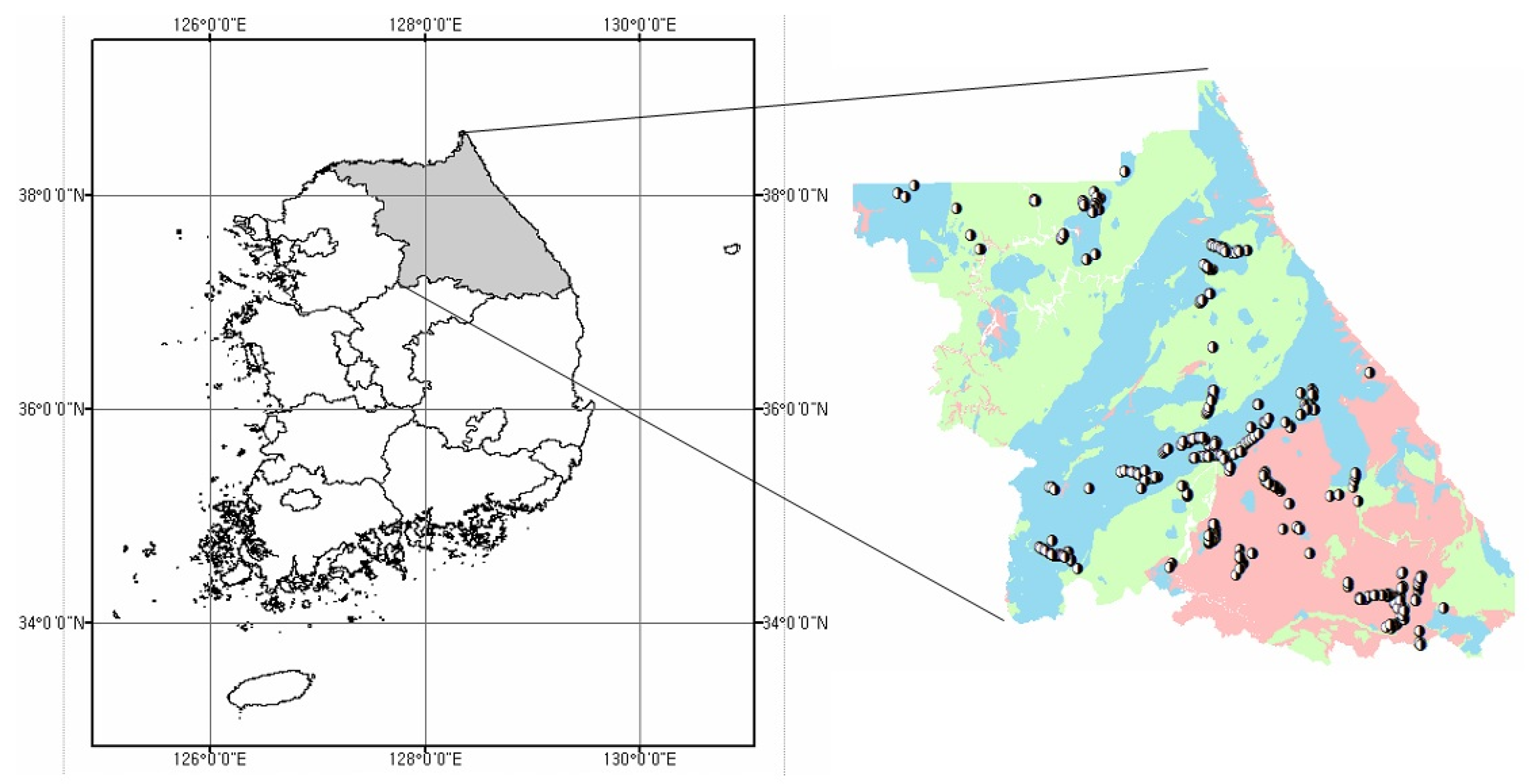

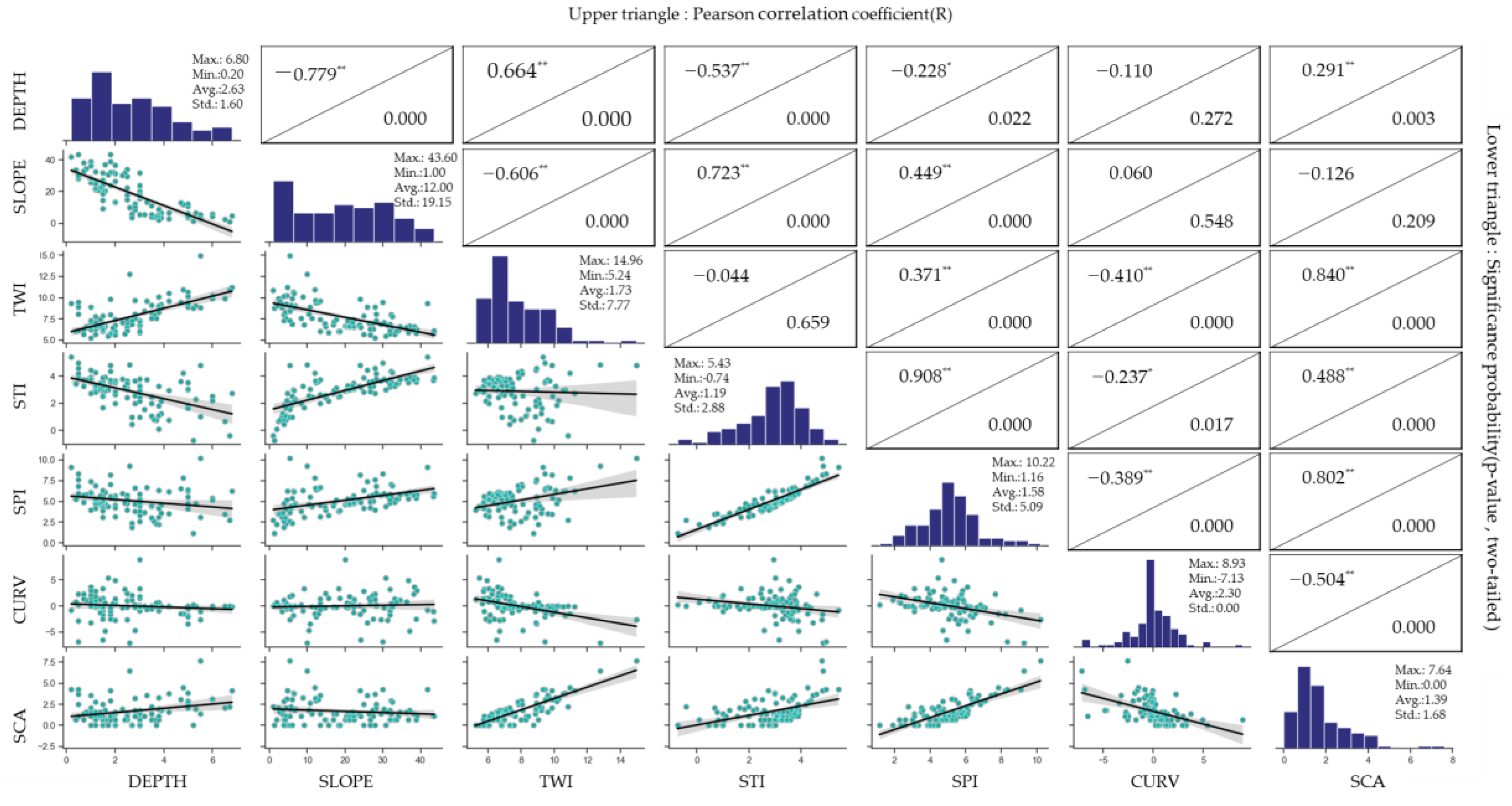
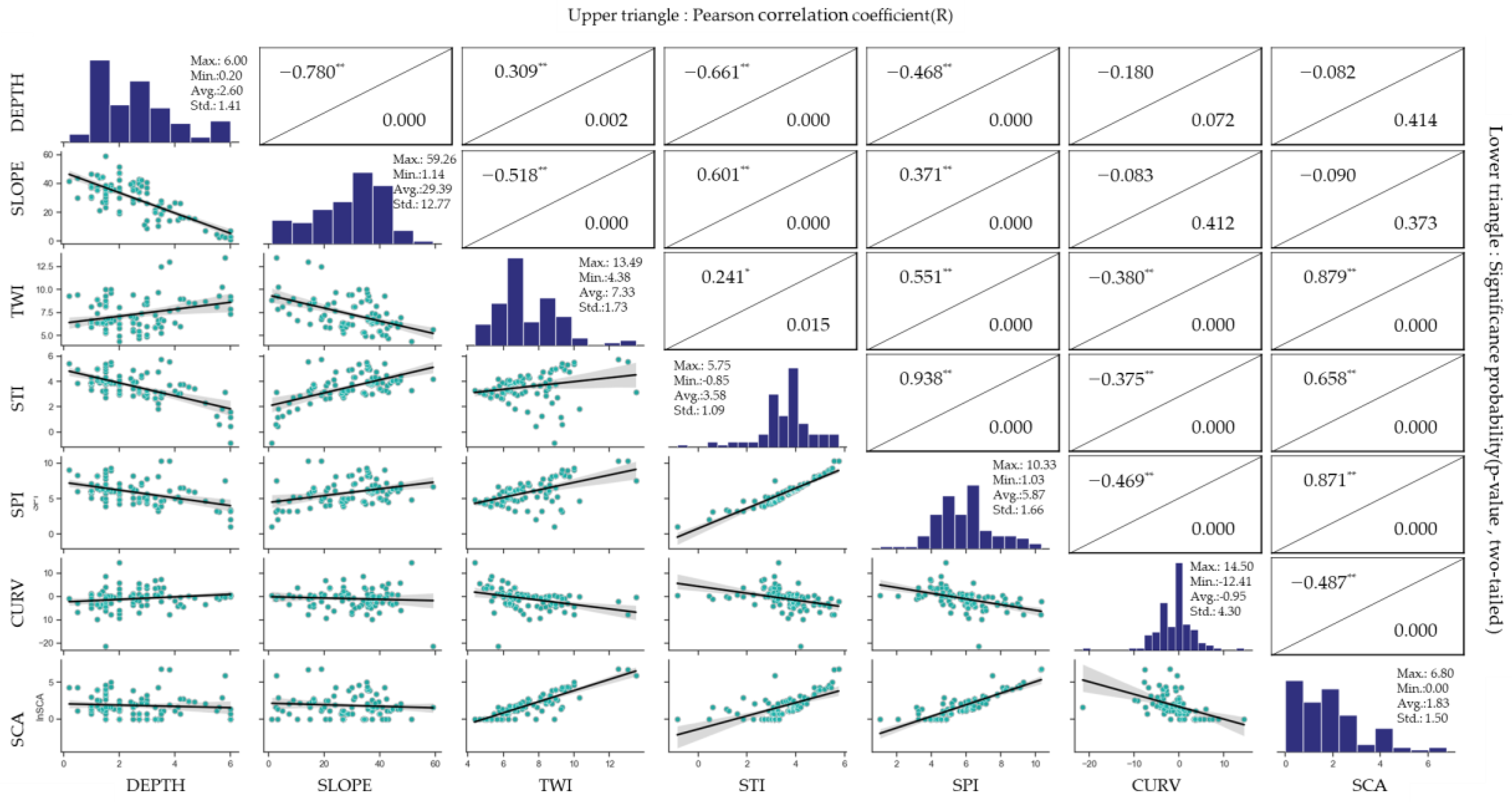
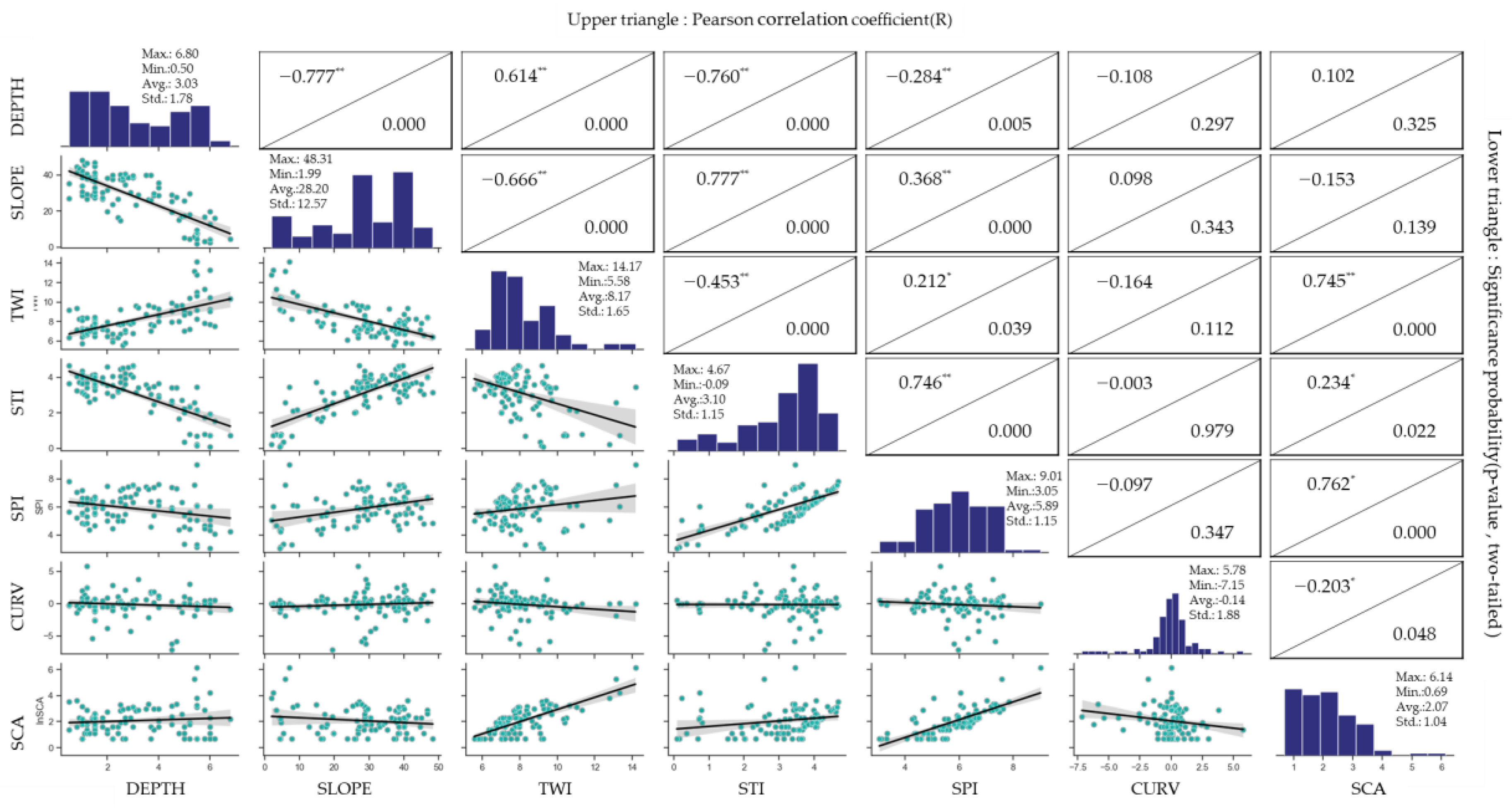
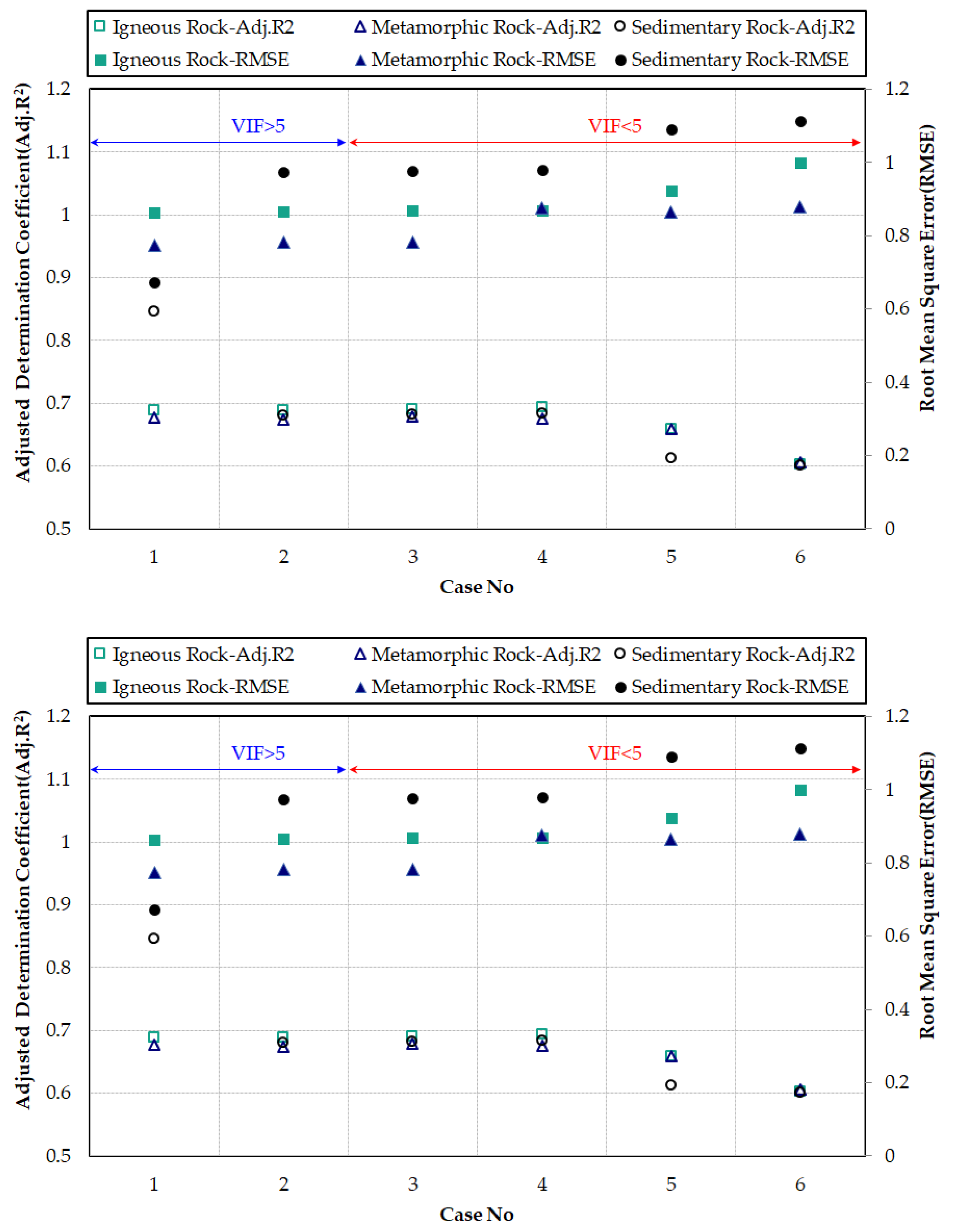
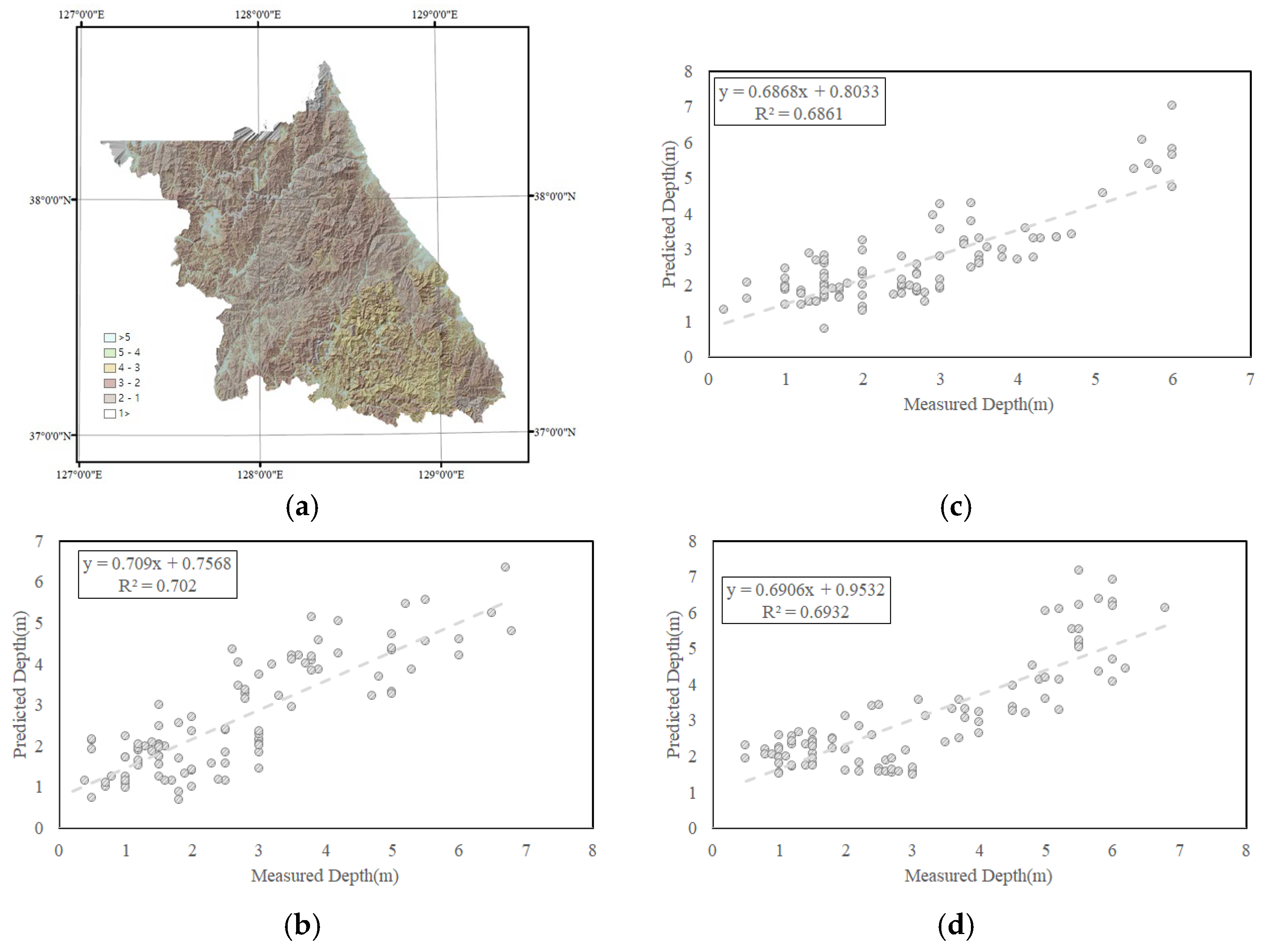
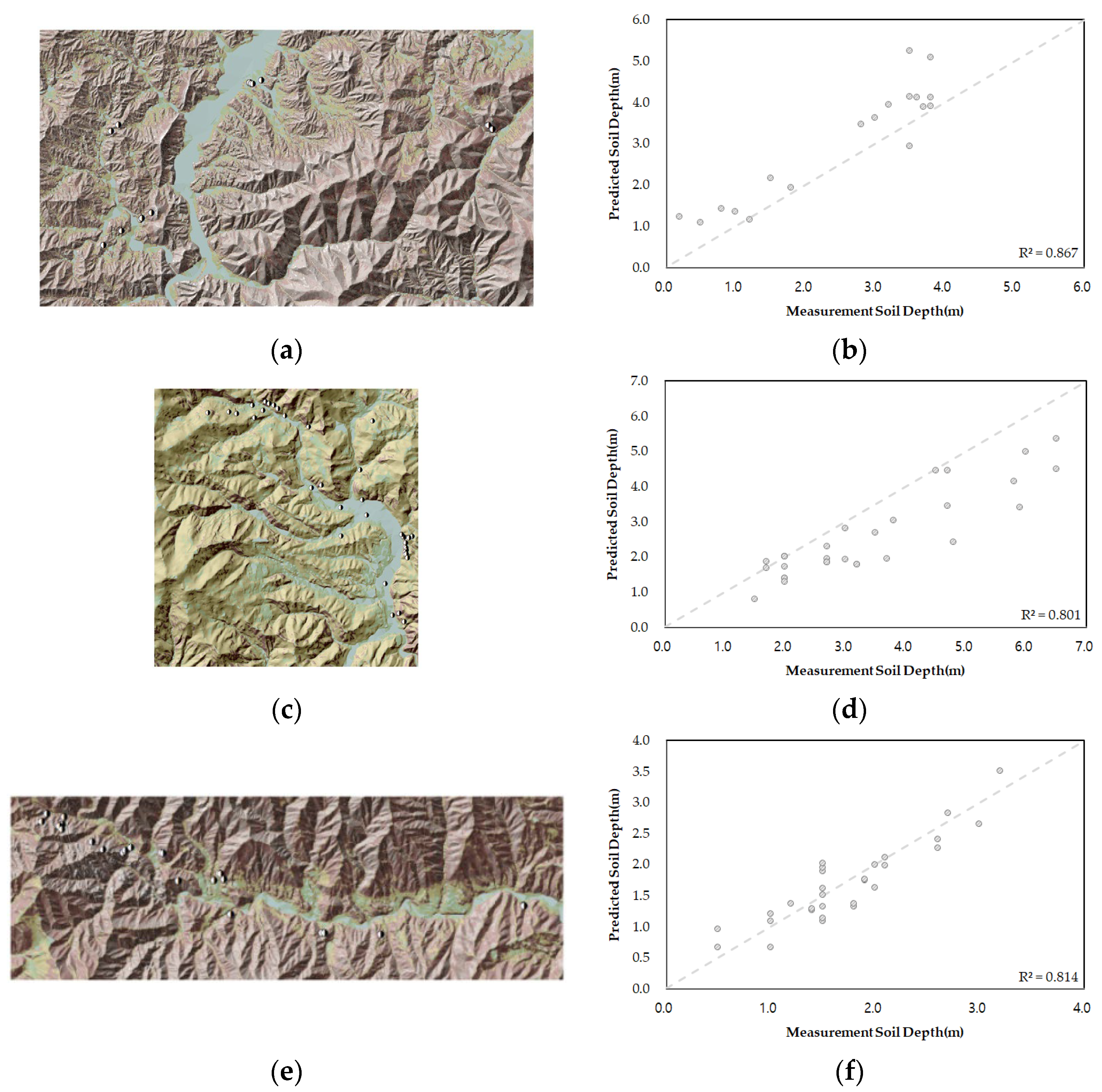
| Terrain Attributes | Define |
|---|---|
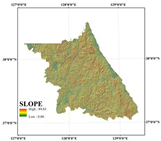 | The SLOPE is defined as the angle between the tangent to the terrain surface and the horizontal plane and is a variable that determines the flow velocity by gravity [44]. |
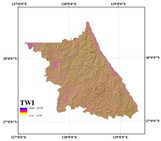 | Topographic Wetness Index (TWI) is an index of the water content in the ground, and it can determine the spatial pattern of water flow [45,46]. TWI was developed by Beven and Kirkby [47] in TOPMODEL and is defined as a function of the upstream contributing area per unit area orthogonal to the slope and the flow direction. Where α is the slope area of the unit grid length, β is the slope at a point on the surface. |
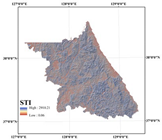 | Sediment Transport Index (STI) was proposed by Moore and Burch [48], and is an indicator of the erosion and sedimentation process. It is defined by the non-linear equation of the specific catchment area and slope. where is a specific catchment area, β is the slope at a point on the surface. |
 | Stream Power Index (SPI) is an index indicating the erosion risk of potential flows on a terrain surface. When the catchment area and slope increase, the SPI also increases as the flow velocity due to gravity increases [45,46] The SPI is defined by the following equation. |
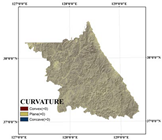 | Curvature has an important effect on landslides and is classified into three types: convex, plane, and concave. In general, it is considered to have a negative effect on the landslide due to ponding caused by more extreme rainfall penetration in the case of the concave curvature relative to that of the Convex [49]. |
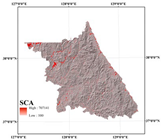 | Specific catchment area (SCA) is defined as the value obtained by dividing the upslope area by the contour width and is a value commonly used in hydrology to analyze the flow of water on the slope [50]. |
| Case No. | Parameter | Igneous Rock | Metamorphic Rock | Sedimentary Rock | |||
|---|---|---|---|---|---|---|---|
| Tolerance | VIF | Tolerance | VIF | Tolerance | VIF | ||
| 1 | SLOPE | 0.012 | 82.070 | 0.010 | 96.059 | 0.270 | 3.706 |
| TWI | 0.002 | 591.425 | 0.002 | 523.360 | 0.021 | 46.671 | |
| STI * | 0.001 | 1166.374 | 0.001 | 1089.255 | 0.027 | 37.516 | |
| SPI | 0.001 | 1836.403 | 0.000 | 2307.441 | 0.061 | 16.270 | |
| CURV | 0.731 | 1.368 | 0.700 | 1.429 | 0.937 | 1.068 | |
| SCA ** | 0.015 | 66.595 | 0.013 | 76.471 | 0.032 | 30.870 | |
| 2 | SLOPE | 0.121 | 8.287 | 0.142 | 7.048 | 0.270 | 3.699 |
| TWI | 0.016 | 63.426 | 0.018 | 56.247 | 0.027 | 37.110 | |
| STI * | 0.062 | 16.075 | 0.068 | 14.708 | 0.055 | 18.134 | |
| CURV | 0.738 | 1.355 | 0.740 | 1.352 | 0.941 | 1.063 | |
| SCA ** | 0.015 | 66.008 | 0.014 | 72.581 | 0.032 | 30.814 | |
| 3 | SLOPE | 0.141 | 7.075 | 0.167 | 5.975 | 0.271 | 3.695 |
| TWI | 0.266 | 3.763 | 0.230 | 4.351 | 0.538 | 1.859 | |
| STI * | 0.239 | 4.181 | 0.221 | 4.516 | 0.384 | 2.604 | |
| CURV | 0.779 | 1.284 | 0.749 | 1.335 | 0.961 | 1.040 | |
| 4 | SLOPE | 0.141 | 7.074 | 0.172 | 5.809 | 0.272 | 3.678 |
| TWI | 0.282 | 3.545 | 0.254 | 3.939 | 0.545 | 1.833 | |
| STI * | 0.244 | 4.107 | 0.221 | 4.515 | 0.389 | 2.573 | |
| 5 | SLOPE | 0.577 | 1.733 | 0.639 | 1.566 | 0.556 | 1.798 |
| TWI | 0.577 | 1.733 | 0.639 | 1.566 | 0.556 | 1.798 | |
| 6 | SLOPE | 1.000 | 1.000 | 1.000 | 1.000 | 1.000 | 1.000 |
| Case No. | Igneous Rock | Metamorphic Rock | Sedimentary Rock | ||||||
|---|---|---|---|---|---|---|---|---|---|
| RMSE | RMSE | RMSE | |||||||
| 1 | 0.707 | 0.688 | 0.863 | 0.697 | 0.677 | 0.773 | 0.856 | 0.846 | 0.672 |
| 2 | 0.704 | 0.689 | 0.866 | 0.691 | 0.674 | 0.781 | 0.698 | 0.681 | 0.973 |
| 3 | 0.704 | 0.691 | 0.868 | 0.690 | 0.678 | 0.781 | 0.695 | 0.682 | 0.977 |
| 4 | 0.702 | 0.693 | 0.870 | 0.686 | 0.676 | 0.876 | 0.693 | 0.683 | 0.981 |
| 5 | 0.665 | 0.658 | 0.922 | 0.666 | 0.659 | 0.864 | 0.621 | 0.613 | 1.09 |
| 6 | 0.607 | 0.603 | 0.999 | 0.609 | 0.605 | 0.878 | 0.604 | 0.600 | 1.114 |
| Proposer | Model | Range of Soil Thicknesses (cm) | Number of Datapoints |
|---|---|---|---|
| Penizek [33] | 40–160 | 553 | |
| Gessler [41] | 0–200 | 30 | |
| Qiyong [4] | 3.1–198.4 | 137 | |
| Han [55] | (Cell size = 10m) | 30–150 | 79 |
| Mehnatkesh [2] | 30–150 | 100 |
| Rock Type | Model | p-Value | Number of Data |
|---|---|---|---|
| Igneous | <0.001 | 101 | |
| Metamorphic | <0.001 | 101 | |
| Sedimentary | <0.001 | 95 |
| Rock Type | R | RMSE | p-Value | Number of Datapoints | ||
|---|---|---|---|---|---|---|
| Igneous | 0.931 | 0.867 | 0.859 | 0.724 | <0.001 | 18 |
| Metamorphic | 0.895 | 0.801 | 0.794 | 1.104 | <0.001 | 30 |
| Sedimentary | 0.902 | 0.814 | 0.807 | 0.288 | <0.001 | 29 |
Disclaimer/Publisher’s Note: The statements, opinions and data contained in all publications are solely those of the individual author(s) and contributor(s) and not of MDPI and/or the editor(s). MDPI and/or the editor(s) disclaim responsibility for any injury to people or property resulting from any ideas, methods, instructions or products referred to in the content. |
© 2023 by the authors. Licensee MDPI, Basel, Switzerland. This article is an open access article distributed under the terms and conditions of the Creative Commons Attribution (CC BY) license (https://creativecommons.org/licenses/by/4.0/).
Share and Cite
Kim, J.; Shin, H. Soil Depth Prediction Model Using Terrain Attributes in Gangwon-do, South Korea. Appl. Sci. 2023, 13, 1453. https://doi.org/10.3390/app13031453
Kim J, Shin H. Soil Depth Prediction Model Using Terrain Attributes in Gangwon-do, South Korea. Applied Sciences. 2023; 13(3):1453. https://doi.org/10.3390/app13031453
Chicago/Turabian StyleKim, Jinwook, and Hosung Shin. 2023. "Soil Depth Prediction Model Using Terrain Attributes in Gangwon-do, South Korea" Applied Sciences 13, no. 3: 1453. https://doi.org/10.3390/app13031453
APA StyleKim, J., & Shin, H. (2023). Soil Depth Prediction Model Using Terrain Attributes in Gangwon-do, South Korea. Applied Sciences, 13(3), 1453. https://doi.org/10.3390/app13031453





